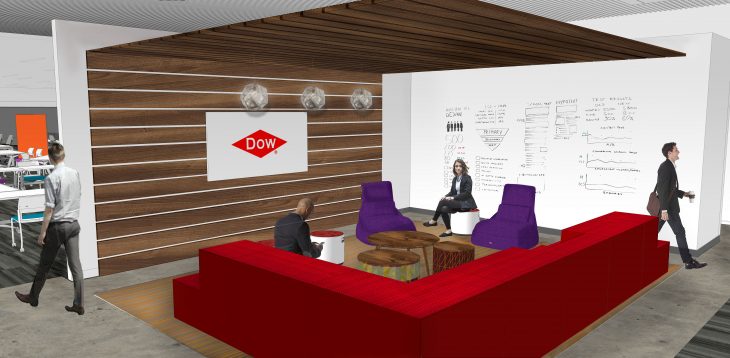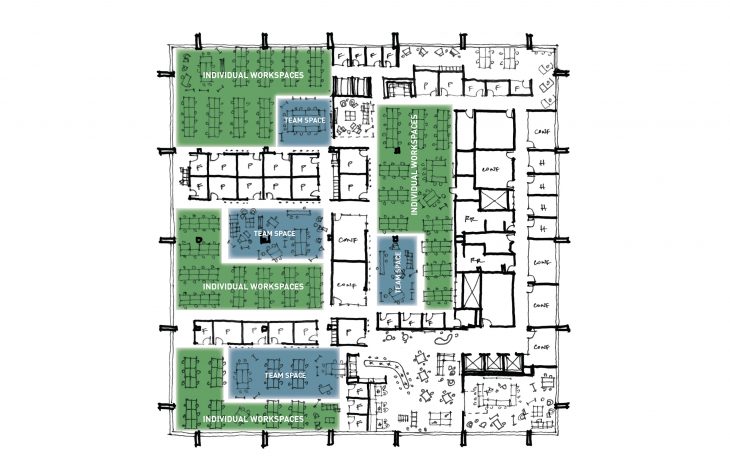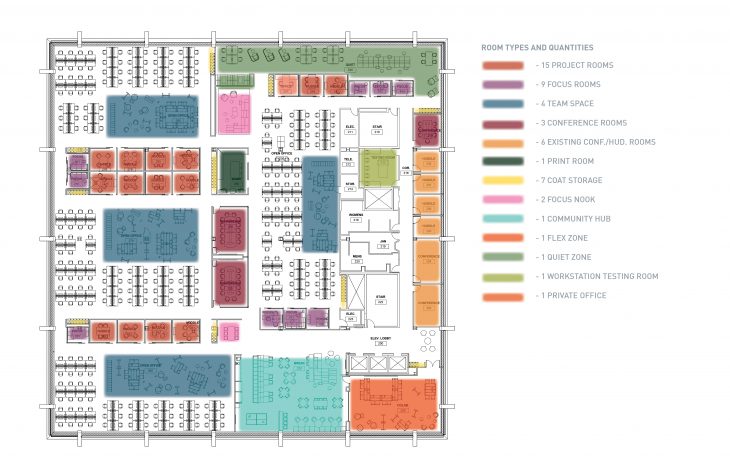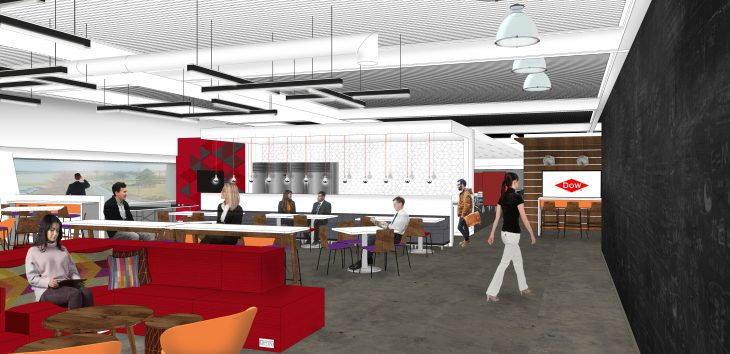Installment 6 of 6. This article is the final in a series of six articles on the growth, value, and future of Design for People. The intent has been to explore and discover the impact of behaviors, habits, and patterns of people in the design of environments. Be sure to check out parts one, two, three, four and five of this series.

Balancing Individual preferences and team priorities
The core challenge in almost all workplace renovation projects is to strike the right balance among individual preferences, team priorities, and the constraints presented by the building. Individuals are habitual. They resolve uncertainty and complexity in their work by seeking out the harbor of predictability, wherever they can find it. This means the vast majority of American workers prefers workplace settings that are conducive to their own particular shade of certainty. Similarly, employees rely on the steadiness and dependability of their teammates to balance the workload and keep the business moving forward. Employees need to know where their teammates are, what they are working on, and when they are going to deliver. The success and stability of the business depend on this information.
What happens, then, when the direction shifts and the business demands change? Something has to give.
The Dow Chemical Story
That was the challenge Dow faced when renovating 27,000 square feet of existing office space to accommodate 250 people located on its Midland, MI campus. Reflecting on the start of the project, Paul Kline, Information Systems Global Director of Employee Experience Services, stated, “We brought together teams from a dozen different parts of Dow, including IT and business process organizations. Most came from a variety of office or cubicle workspaces with a heavy reliance on meeting rooms and audio conferencing for collaboration.” Rather than refresh the new space by replicating the sorts of environments people were accustomed to, Kline and the team recognized that the future workplace would look nothing like workplaces of the past. “One of the primary objectives of the project was to bring work groups that were spread across multiple sites and buildings together in a single location to allow for greater collaboration across teams to drive more innovative ideas and solutions,” said Paul Barbeau, Real Estate Strategy and Facility Development Director.

BHDP led the Dow team through a series of visioning sessions, interviews, and focus groups. As a result, an overarching organizing concept emerged. Kline says, “Our vision for the project was to create a vibrant, agile workspace at scale that we could use for project-based teams. We wanted a workspace that would increase collaboration and knowledge sharing within and across teams and enable faster delivery of solutions.” In short, the team needed a space that embraced the principles of agile development, scaled to the size of the organization.
Since the publication of the Agile Manifesto in the early-2000’s, much has been written about “agile” development – a contrasting workflow to the preceding “waterfall” development model previously practiced in the IT industry. Typically, the agile development model relies on a series of successive scrums and sprints, the rapid release of working prototypes, continuous testing and refining of these prototypes, the welcoming of changes in requirements no matter how late in the process, and the uninterrupted flow of information among members of the project team.
Many IT teams have embraced this model, and it is not uncommon to find teams of 8-12 employees working together in a dedicated project room that can be at times energetic and frenetic, and at other times quiet and focused. Dow endeavored to scale the behaviors of these project teams to meet the demands of the business. The design team accomplished this by breaking down the program into more manageable neighborhoods, isolated by a series of closed and open support spaces.
Kline states, “Creating an agile workspace at scale was challenging. The floor holds 250 people, so breaking it up into four neighborhoods created a nice balance between open and focused. At this scale, a significant amount of floor space was freed up from the reduction of space dedicated to each individual. This collective free space was used for a large community area for social activities, a ‘garage’ where we can close the overhead door and run loud design thinking workshops, and a ‘library’ quiet zone where there is drop-in seating for focused work.” The end result of this innovative design resolved the conflicting priorities for both individual- and team-based work and delivered free area back to the business to create an inviting sense of place.

The Results of the New Design
The design team organized the floor into four neighborhoods of 60-65 people. Each neighborhood is comprised of a set of bench-style workstations encircling a team space at the center. The heart of each neighborhood, the team space, consists of a variety of loose furniture, shared storage, and mobile white boards that can be rearranged to create enclaves for more intimate conversations within the open environment. Alternatively, these settings can also support stand-up sessions with the entire neighborhood at key points within the project delivery. Barbeau says, “It’s been inspiring to see how the space has been a catalyst to build a stronger culture. The teams have held several team building activities in the new space: friendly ping pong tournaments, a putt-putt golf competition to benefit local charities, and Guest DJ Thursdays.”
At the perimeter of each neighborhood is a suite of enclosed break-out spaces to support teleconferences, virtual information display, and white-boarding. These project rooms accommodate 1-4 people and are suitably scaled to the program. In addition, the designers included two traditional 12-person conference rooms but noted that preference for these sorts of environments is being replaced by smaller meetings and open collaboration in the team spaces.
To support the needs for heads-down time, BHDP included a set of enclosed focus rooms, two semi-enclosed focus nooks, and a narrow, linear library at the perimeter. Each of these spaces offers unique furniture settings and lighting, and the library is positioned along the exterior glazing to offer users ample natural light and views.
People enter the space alongside the hub of the program—a community space and an innovation space linked by a sliding garage door. These spaces are positioned at the corner of the building, adjacent to vertical circulation and views, but separated from the neighborhoods to minimize the spillover of noise from free-wheeling innovation sessions.

Culture Shift
Ultimately, the yard stick by which a project should be measured is whether it is impacting business performance. Barbeau states, “We conducted post-occupancy feedback sessions 90 days after the teams moved in. One of the most consistent comments from employees was that the new environment allows colleagues to connect with each other to collaborate and develop solutions much quicker.” Adds Kline, “We are seeing new behaviors around quick in-person discussions, ad-hoc brainstorming, and more social interactions. We are achieving the increased collaboration and knowledge sharing that were parts of our objectives, but we haven’t yet measured if this is translating into faster delivery of solutions. In our post-occupancy survey, we scored above US and company averages on most dimensions.” So, while changes in the space have not yet translated to top-line performance metrics, the bottom line is that occupants are pleased with the space. “The two most common descriptors we hear are ‘light’ and ‘energetic’. The combination of natural light with an open layout makes a big impact in the feel of the workspace. The level of movement and interaction create a high sense of energy for everyone.”
In the spirit of agile development, Kline and the team embraced the need to continuously tinker with the environment. In response to concerns about the balance of focus and interaction, Kline continues, “We need to continue to reduce the amount of distractions for people trying to focus, so we’re running workshops with our teams to see how we can raise awareness of and adjust our behaviors while keeping the same level of energy.”
Agile by Design
Ultimately, in order to design for people, designers have to design with people. The future workplace is less about the mathematical composition of ordered units and more about embracing the messier parts of human behavior that foster rich connections and deliver breakthrough ideas. Creating this shift demands relinquishing outmoded ideas and steering in to the mess. As exemplified by Dow, the future looks a lot like the embodiment of the agile principles in space.


